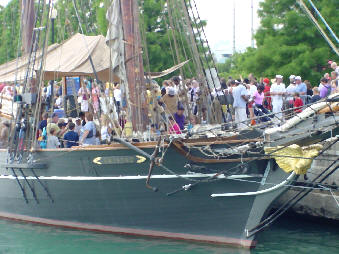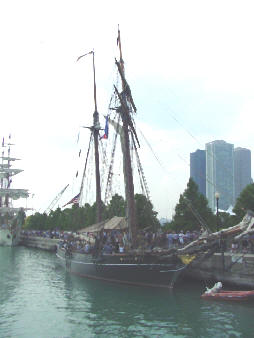|
Recently, Chicago hosted the over two-dozen tall ships. The two
that I most wanted to visit were the HMS Bounty and the Amistad.
Strangely, these two ships have much in common. Mutineers seized both vessels:
one group consisted of British sailors and the other of African slaves. Both
ships set sail on their respective voyages to service slavery. The Bounty
wanted to find a source of cheap food to feed slaves and the Amistad was
transporting cheap labor. Finally, both groups of mutineers reflected courage
and determination to stop being victims of degradation and abuse. Having boarded and paid my homage to the HMS Bounty's crew, I went on to the Amistad. The ship's journey into history books took place in the New World, but the mutineers' journey began months before in Africa. Fifty-three Africans were kidnapped from Mendeland (present-day Sierra Leone). Week's later, they found themselves in Cuba where they were sold as slaves. On June 28, 1839, they boarded the Amistad for a voyage from Havana to Puerto Principe, Cuba where a plantation and slavery awaited them. After three days at sea, Cinque, the Amistad's version of the Bounty's Fletcher Christian, lead the mutineers in their seizing of the ship. In the battle for the ship, the Cuban crew died, but the two Spaniards were spared so that they could sail the Amistad back to Africa. However, the two Spaniards sailed north instead along the coast of the United States. Two months later, the U. S. Navy seized the ship off the coast of Long Island. The two Spaniards demanded possession of the ship and the mutinous slaves.
Steven Spielberg's movie in 1997 popularized the story of the Amistad. In wake of the movie's success, a replica of the ship sails from port to port as did the ancient mariner in Coleridge's famous poem. The ancient mariner warned his listener's-
The Amistad carries with her the same message to all who visit her. This former slave ship is a visual reminder of the tragic history of slavery and of those that successfully fought to be free. Hundreds of thousands of young and old gain a better insight into history because of her mission. In addition to exhibits and displays, it is noteworthy that the Amistad's captain is an African-American. Captain Bill Pinkney commands this floating school for racial tolerance and understanding. I wish that I could have interviewed him and asked about what it must feel like sailing a ship with such a bi-polar history-one history of total depravity and the other of the transcendent will to be free. What benevolent and malevolent ghosts must walk that ship in the darkness of night? What must an African-American captain of a former slave ship think as he sails from one port-of-call to the next? Sail on and Bon Voyage, Amistad.
This article appeared in the Dixon Telegraph on 10/13/03.
|







 Thus began another long journey
through the American judicial sea. The slaves were charged with piracy and
murder. However, a group of Christian abolitionists headed by Lewis Tappan
formed a defense committee. Attorney Roger Sherman Baldwin, with help from
former President John Quincy Adams, took the case to the United States Supreme
Court, which ruled that the Africans were not guilty and released them to go
back to Africa as free people.
Thus began another long journey
through the American judicial sea. The slaves were charged with piracy and
murder. However, a group of Christian abolitionists headed by Lewis Tappan
formed a defense committee. Attorney Roger Sherman Baldwin, with help from
former President John Quincy Adams, took the case to the United States Supreme
Court, which ruled that the Africans were not guilty and released them to go
back to Africa as free people.